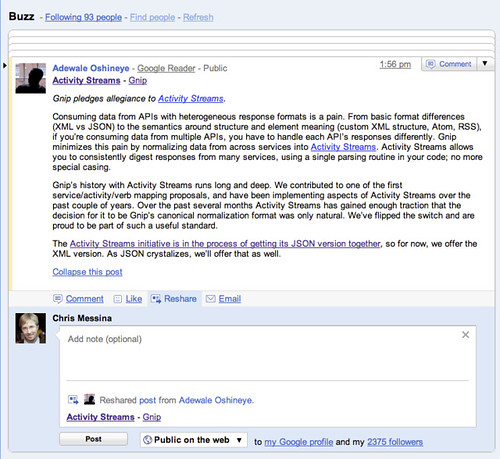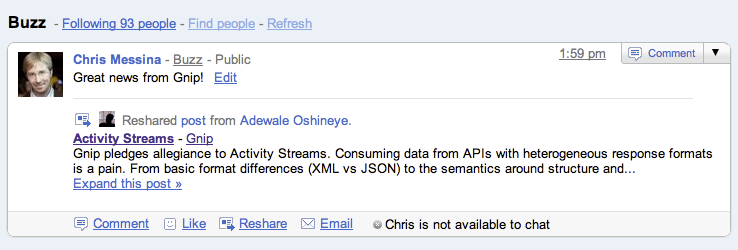Description
The resharing activity is equivalent in intention to the act of forwarding an email or reposting an object that someone has seen, usually in the context of a stream.
Twitter offers this with a feature called "retweet", which started out as a community convention denoted by posted prefixed with "RT @username". Eventually Twitter implemented support for one-button retweets.
Google Buzz offers similar functionality called "reshare", but with the ability to add your own annotation to a reshared activity or object. You can also configure your privacy or audience settings when resharing.
Status.net also supports this action, but uses the verb "repeat" (originally called "redent").
Objects
The reshare verb can apply to any object, but interestingly also can apply to activities as well.
URI
http://activitystrea.ms/schema/1.0/share
Format
{
"author" : "Chris",
"verb" : "share",
"annotation" : "You go to it",
"object" :
{
"objectType" : "activity",
"recipients" : [
{
"displayName" : "Adina Levine",
.....
}
],
"author" : "Martin",
"postedTime" : "10/10/2010 09:00:00"
}
"postedTime" : "12/12/2010 10:00:00"
}
Examples
Google Buzz

Reshared post:

Facebook

Tumblr

Notes
One of the challenges with the reshare verb — like bookmarking — is how to represent what's going on given the actor-verb-object archetype.
The two options follow two code paths, approximately like this:

On the left, the reshare activity could be treated as a posted note, with an attachment that would simply include the content (and attributes) of the originally shared object. In the case where no annotation is provided, the content of the note would simply be blank. This has the nice benefit of being compatible with existing implementations. The problem is that naive activity consumers would possibly ignore the attachment, rendering a note that talks about something that doesn't exist (because it is unaware of the attachment element).
On the right, an alternative approach is to use the "share" verb, with the object being the entire original activity, and having an object-type of activity. If there is an annotation provided by the resharer, it would be captured in the activity:annotation attribute. Naive parsers would generally not know what to do with this kind of activity, which would actually be a good thing — since the goal is to model someone resharing someone else's original shared content or object.*
The preferred and recommended model for resharing, therefore, is to use the "share" verb coupled with an object-type of "activity". If the user supplies an annotation, it would be expressed in the activity:annotation field (note that ActivityStreams annotations are unrelated to Twitter's Annotations feature).
It may be possible to present a reshared activity in a way that naive parsers can handle by embedding the original activity as the content of a blockquote:
-entry
--title /
--author /
--content
---inline annotation
---"Reshared post from [Original author]"
---blockquote
----content from original activity
---/blockquote
--/content
-/entry
Implementations
Resharing activities can be found in Twitter (retweet), Google Buzz (reshare), and Status.net (repeat).
Maintainers
- Chris Messina
- Will Norris
Comments (2)
John Panzer said
at 12:29 pm on Aug 25, 2010
For activities that also support comments, a reshare+annotation is similar to a bare reshare + a comment. I'm not sure there's a real semantic difference between these two cases; if there is, this page should call that out; if not, perhaps we should make sure that these two cases are as similar as possible (which I think points towards a "share" + optional annotation).
I would ask what happens with chains of reshares-of-reshares though.
Chris Messina said
at 6:17 pm on Aug 29, 2010
The two cases you describe sound equivalent to me. You are right though — chains of reshares, especially with annotations left in tact — could post a significant challenge if we don't specify how annotations are passed through subsequent reshares...
HTML solves this with nested blockquotes. Can we do the same with Atom?
You don't have permission to comment on this page.